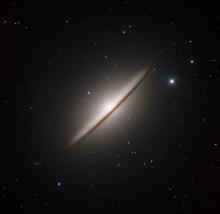Listen to today's episode of StarDate on the web the same day it airs in high-quality streaming audio without any extra ads or announcements. Choose a $8 one-month pass, or listen every day for a year for just $30.
You are here
Big Disruption
“Spaghettification” sounds like prep work for a big pasta dinner. But for scientists, it’s something even tastier: the destruction of a star by a black hole. It reveals details about the star, the black hole, and the galaxy they inhabit.
It happens when a star passes too close to a black hole — especially a supermassive black hole at the heart of a galaxy. As the star gets close, the black hole’s gravity starts to pull it apart.
The destruction is known as a T-D-E — a tidal disruption event. The black hole’s gravity pulls more strongly on the side of the star that’s closest to it, so it rips the star apart in strands — like pieces of spaghetti.
The star doesn’t go quietly, though. It produces a huge outburst of energy. And it produces more energy later on. Some of the star’s hot gas forms a disk around the black hole. That produces X-rays. The disruption also creates a cloud of gas and dust, which absorbs the X-rays and emits infrared energy.
Powerful magnetic fields also direct some of the star’s gas back into space in high-speed “jets,” which produce radio waves.
Astronomers have discovered more than a hundred T-D-Es in the last couple of decades. They can use the details of each event to calculate the mass of both the dying star and the black hole. They also can learn about the environment around them — like figuring out which spices are in the sauce as a black hole consumes a “spaghetti” dinner.
Script by Damond Benningfield





